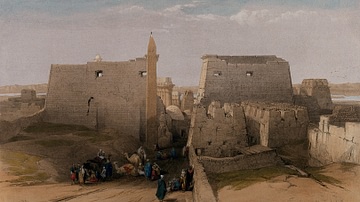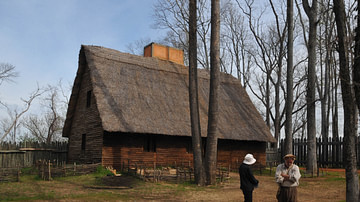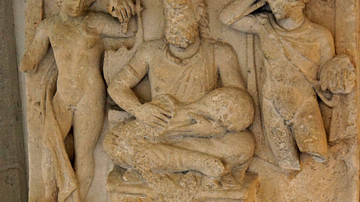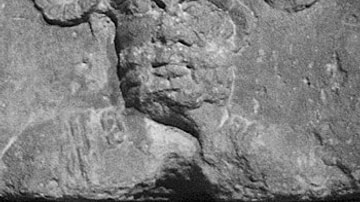Search Images
Browse Content (p. 676)

Image
Entrance to the Temple at Luxor
Entrance to the temple at Luxor, Egypt. Coloured lithograph by Louis Haghe after David Roberts, 1848 CE. Wellcome Collection, London. David Roberts travelled in the Middle East and North Africa, particularly Egypt, from 1838 to 1839 CE...

Image
Minoan Bronze Shield
Bronze shield, Crete, Geometric period, 8th-7th century BCE. Heraklion Archaeological Museum, Crete. The bronze tympanon/shield found in the Idaean Cave is a votive offering from around the 8th century BCE. It is decorated with a bas-relief...

Image
Wayland the Smith
Close-up of the front panel of the Franks Casket, Auzon, France, 8th century CE. The British Museum, London. This part of the casket features an Anglo-Saxon depiction of the Wayland (Volund) legend. Wayland is depicted next to his forge...

Image
Reconstruction of Mount Malady, Henricus Colony
Reconstruction of Mount Malady, the first English hospital built in North America c. 1611 CE, at Henricus Colony of Virginia. It was destroyed in the so-called Indian Massacre of 1622 CE when the Powhatan Confederacy launched the Second...

Image
Reconstruction of a Colonist's Home, Henricus Colony
Reconstruction of an English colonist's home at Henricus Colony of Virginia, c. 1611 CE.

Image
Cernunnos, Gundestrup Cauldron
The horned-figure frequently identified as the Celtic god Cernunnos. A detail from an interior panel of the Gundestrup Cauldron. The cauldron was found in Denmark in 1891 CE but was produced in the Balkans. Gilded silver, likely 1st century...

Image
Cernunnos Rheims Relief
A 1st century CE bas-relief showing the Celtic god Cernunnos and Apollo (left) and Mercury (right). (Musée Saint-Remi, Rheims, France)

Image
Cernunnos, Nautae Parisiaci
A depiction of the Celtic god Cernunnos from the pillar known as the Nautae Parisiaci ('Seaman of the City of Paris') which was dedicated to Jupiter. Gallo-Roman, 1st century CE. (Musée National du Moyen Age, Cluny, France).

Image
Indian Massacre of 1622
Indian Massacre of 1622. A colorized version of a woodcut by Matthaeus Merian published along with Theodore de Bry's earlier engravings in a book on the New World, 1628. The engraving shows the 1622 massacre when Powhatan Indians attacked...

Image
Powhatan Stone
The Powhatan Stone, a historical marker erected by the Association for the Preservation of Virginia Antiquities in Chimborazo Park, Richmond, Virginia, USA. It was placed by the Mayo family of Richmond who once owned the property where the...